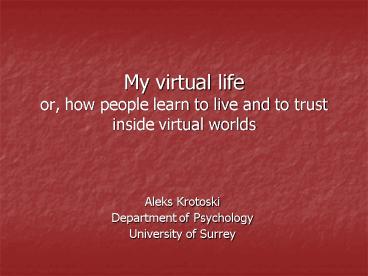My virtual life or, how people learn to live and to trust inside virtual worlds - PowerPoint PPT Presentation
1 / 14
Title:
My virtual life or, how people learn to live and to trust inside virtual worlds
Description:
Chatrooms, forums, MySpace, Craig's List, London Memorial ... or some kind of disinterested third party (e.g., Craig's List or MySpace) ... – PowerPoint PPT presentation
Number of Views:549
Avg rating:3.0/5.0
Title: My virtual life or, how people learn to live and to trust inside virtual worlds
1
My virtual lifeor, how people learn to live and
to trust inside virtual worlds
- Aleks Krotoski
- Department of Psychology
- University of Surrey
2
This talk
- Richard spoke about an example of trust in
virtual worlds RMT - Ill be explaining how people live in virtual
worlds, how they interact in virtual worlds and
how they grow to trust one another in virtual
worlds
3
Before I get ahead of myself
- The differences between online and offline
- Anonymity
- Physical appearance
- Physical proximity
- Greater transience (more weak ties)
- Absence of social cues
- So how can we expect community to grow?
4
Social groups can look like this
5
or they can look like this
- London Memorial in the virtual world Second Life
- Between 12-1pm on 7 July 2005, over 150 Second
Life residents visited. It was open for 7 days
and racked up thousands of visitors - Fewer than 10 claimed any British ties
- Makers motivations were altruistic and purely
community-driven
6
Online community I
- In traditional definitions of community,
thered be no such thing in cyberspace - Tied to place, experience and artifacts
- To misquote AOL ads, how can you fall for someone
youve never met? - But we know thats not true
- Chatrooms, forums, MySpace, Craigs List, London
Memorial - These virtual worlds are the places which the
online communities are tied to, and they all rely
upon trust heuristics
7
Online community II
- Because of their immense size, communities emerge
as sub-groups (guilds) in the virtual world
population its an explicit part of the design
people must rely upon one another to survive
and advance - Form for the same reasons offline communities do
- Make friends, provide motivation, offer support,
meet like-minded others - Theyve also got their own unique purposes
- Raid, hunt, gather, ensure safety, divide the
bounty of efforts - Whatever role trust plays in offline communities,
it plays in online communities because these
interactions are human-bound
8
Trust in virtual communities I were all in it
together
- Returning to Anonymity
- Perceived similarity (levelling the playing
field) - No social cues, so lots of uncertainty
- Expectations of openness and honesty engenders a
culture of mutual sharing - Relevant Social Psychological dimension of trust
- Similarity of goals and values
- Expectations of future interaction
9
Trust in virtual communities II Actions speak
louder than words
- You dont go into virtual worlds to just be
- These are task-oriented environments, with high
levels of commitment required - In the goal-oriented spaces, everyone has a role
in the social fabric ownership - Trust develops as a result of historical
experience. Which leads to
10
Trust in virtual communities III Reputation,
reputation, reputation
- Its the only real currency in virtual worlds
- Reputation is the basis for all relationships in
virtual worlds - Think eBay
- Visual heuristics of trust players can tell an
avatars reputation and affiliations just by
looking
11
Trust in virtual worlds III Reputation
(continued)
- Trust is based upon
- past experience
- which is either based upon functional goals or
pre-existing social relationships - or some kind of disinterested third party (e.g.,
Craigs List or MySpace) - And speaking of social networking applications,
the same principles work in-world too - Finally, you must comply
- A non-official policing force in a space where an
official police is absent - The emphasis is on friendship and dedication to
the group - Rejection is cruel
12
Trust in virtual communities III Branding
- RMT leads to business models based upon trust in
a brand - More important in social virtual worlds where RMT
is the game
13
In Sum
- Virtual communities operate in very similar ways
to other communities both on and offline - They bring together distributed individuals based
on common experience, motivations and reputation - This is particularly true for virtual world
participants because of the explicit social
design of the software - There is a great potential for crossover between
the two spheres, BUT any new implementations
should be carefully integrated within the
existing social norms of these valuable virtual
communities lest trust be undermined.
14
Thank you
- Aleks Krotoski
- a.krotoski_at_surrey.ac.uk




























![NOTE: To appreciate this presentation [and insure that it is not a mess], you need Microsoft fonts: PowerPoint PPT Presentation](https://s3.amazonaws.com/images.powershow.com/6387942.th0.jpg?_=20200719041)


